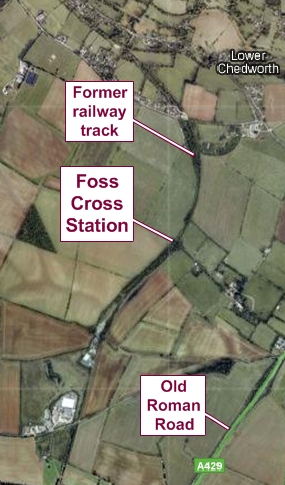Foss Cross Railway Station's Cross
Foss Cross Railway Station was not specifically built for Christian worship. So why is 'Cross' part of the name?
Foss Cross Station
Foss Cross Railway Station is closed. And that's a great shame; in many ways it was a model for passenger comfort and safety.
The problems plaguing other railway stations in Britain and around the world, were conspicuously absent at Foss Cross.
No long lines of frustrated passengers waiting to buy a ticket, no annoying use of mobile phones or portable music players, no pick-pocketing etc... These things just didn't happen.
And the reason? Well, it was so isolated that there was seldom more than one passenger a day. The station opened in 1891, closed in 1961 and was used mainly for the movement of agricultural produce.
The name 'Foss Cross' simply comes from the crossing made by a local lane over the old Roman road called 'Fosse Way'. (The 'e' dropped to sound more modern). Fosse is the Latin for 'ditch' or 'trench', and the Fosse Way (now known as the A429) travels along many ditches all the way across England.
And that's about all we can say about the name Foss Cross. Its eponym is Fosse Way and there's a small lane crossing it.
For some recent photos of the station and a few more details about the line, see Mike Barnsley's Swindon's Other Railway.
Alternatively, stay on this page for a bit of related nonsense.
Given how ancient the area is, we were surprised to find a dearth of local ghost stories. The following is all we've found:
A few minutes drive north of Foss Cross takes you to Chedworth Roman Villa. Here, eerie screams have been heard and the story goes that boy slaves were accidentally burnt alive while being forced to work under the villa's heated flooring.
A little further north takes you to the haunted Compton Cassey; a house built over another Roman villa. Several exorcisms have been carried out to rid the house of these demons.
Ghosts of Roman soldiers, patrolling for troublesome rebels, have been seen in the surrounding countryside; but only the top half of the ghosts. This is explained by the 'fact' that the ground level is a few feet higher now than 2,000 years ago.
As for Foss Cross station itself, however, no spooky apparitions at all. But as we mention above, hardly anyone goes to Foss Cross. So the ghosts may be there, just waiting to leap out and woo-oooooah somebody.
And since the few remaining station buildings are dilapidated and deserted, Foss Cross Railway Station qualifies to be called a 'ghost station'.
¶ Other railway stations with 'Cross' in the name
See: romans-in-britain.org.uk/... for an excellent map of Roman roads in England
Swindon's Other Railway: swindonsotherrailway.co.uk/...

